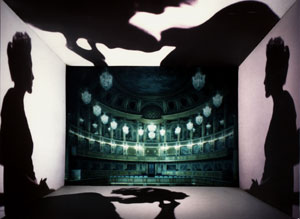FOR IMMEDIATE RELEASE
May 19, 2008
New Unseen Worlds Records release of
Elodie Lauten: The Death of Don Juan: An Opera in Two Acts
on July 29, 2008
Review copies available now.
Catalog #: UW04 Formats: CD, digital
Distributed by: Forced Exposure, Darla, Wayside Music,
Mimaroglu Music Sales, Verge (Canada), Omega Point (Japan),
Art into Life (Japan)
RIYL: Arthur Russell, Philip Glass, David Borden, Peter Zummo, Robert
Ashley, 70’s Downtown NY, Lovely Music Ltd..

The Death of Don Juan CD is a reissue of the original LP recording, including
cover art by John Massey, original liner notes by John Schaefer and additional,
recent liner notes by Kyle Gann, and performances by Arthur Russell and
Peter Zummo. This marks Elodie Lauten 27th release to-date. The Death
of Don Juan, released in 1985 (with assistance from the National Endowment
for the Arts Opera/Musical Theater program) was on WNYC’s top ten recordings
of that year. It was premiered as a live multimedia production at the
Institute of Contemporary Art in Boston in 1997 with support from the
Massachusetts Council on the Arts. In 1988, The Village Voice commented
it was “a cohesive and compelling major work”. Then it became largely
forgotten and never received a New York premiere. However, in the past
few years, Elodie Lauten’s The Death of Don Juan has generated renewed
interest. It is currently listed in Wikipedia
as “one of the major postminimalist works of the 1980s”. Alan Licht listed
it as #3 on his Minimalist Top Ten, calling it “one of the great lost
experimental records of the 80s” (http://www.volcanictongue.com/?p=170).
In 2005, director Robert Lawson, who came across the original LP through
a friend, loved the music and staged a cast of 30 in a student production
at Franklin Pierce College using the original recording.
In terms of libretto, which was also written by Lauten, The Death of Don Juan is a “neo-opera” using a nonlinear storyline based on the cathartic experience of a timeless Don Juan archetype (staged as an unseen character, screen character or a multiple) facing death in the form of a woman, with a complex emotional, sexual, political and spiritual subtext that addresses concerns of our time.
Musically, the underlayment of the piece is a series of orchestral tracks with either a fast, steady pulse from plucked strings, or slow, sustained patterns from woodwinds, realized on an early computer music instrument, the Fairlight, at New York University. The computer programs were not composed traditionally but programmed from a matrix devised by Lauten, called The Scale of Number Seven matrix details and full score of the matrix, additional diagrams under 7-tier hierarchies). The second layer consists of semi-improvised tracks on cello (Arthur Russell), trombone (Peter Zummo), electric guitar (Bill Raynor) and on the Trine (a custom-designed lyre) and harpsichord by Lauten. The vocal tracks are also layered, combining Lauten’s natural spoken and singing voice and the operatic soprano Randi Larowitz, singing in multiple languages (English, French, German, Italian and Latin). Overall the composition is the product of very precise planning augmented by structured improvisation.
Daughter of a jazz pianist, drummer and composer, Errol Parker, Elodie Lauten started her music career as a songwriter. As a young girl, with the all-female rock band Flaming Youth she performed with Allen Ginsberg; in Paris around 1975 she became known as one of the initiators of avant-punk, but soon after went on a spiritual quest, studied with Sri Chimoy for several years then embraced Tibetan Buddhism. As a result, she became more concerned with music as consciousness, and with the relation between music and the environment. Several of her pieces are based on “earth tones” which are in sync with the rotation of the earth (Tronik Involutions, Variations on the Orange Cycle). In the early eighties she joined ranks with Arthur Russell, when the expression “new music” meant transitioning from rock to classical composition. She became known as an experimental composer-performer, often performing solo on the piano or synthesizer along with complex pre-recorded tracks. Through studies of Indian music with LaMonte Young and Pandit Pran Nath she was introduced to alternative tunings and temperaments, and since the 90s she has been marginally involved with the microtonal movement. In the early 90s she retreated to New Mexico for two years to devote herself exclusively to composing. Since the mid-90s her music was released nationally in the U.S. and also in Europe, and she began receiving requests for chamber and orchestral music. This led to more “neo-operas” such as The Deus Ex Machina Cycle for Baroque ensemble and Waking in New York, which was showcased at the New York City Opera Vox series (2004).
###
Contact: Tommy McCutchon
Unseen Worlds PO box 644, Austin, TX 78767
Tel: (512)420-0703
www.unseenworlds.net www.myspace.com/unseenworlds
Email: tommy@unseenworlds.net